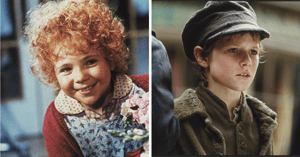 Since 1977 when Annie opened on Broadway, theatrical artists have been portraying endangered youth who have experienced both maltreatment and engaged in delinquent behavior like Oliver Twist and Little Orphan Annie.
Since 1977 when Annie opened on Broadway, theatrical artists have been portraying endangered youth who have experienced both maltreatment and engaged in delinquent behavior like Oliver Twist and Little Orphan Annie.
Oliver! and Annie, two of Broadway’s most iconic musicals, star two children caught between Juvenile Justice and Child Protective Services.
Oliver!
A ragtag family of orphaned children pickpockets welcome little Oliver into their criminal family as they sing:
🎵CONSIDER YOURSELF🎵
Consider yourself at home
Consider yourself one of the family
We've taken to you so strong
It's clear we're going to get along…
If it should chance to be
We should see
Some harder days
Empty larder days
Why grouse?
Always-a-chance we'll meet
Somebody
To foot the bill
Then the drinks are on the house!
Annie
Annie and the other orphans tap out their up-tempo resilient song of maltreatment:
🎵HARD KNOCK LIFE🎵
It's a hard-knock life for us
It’s a hard-knock life for us
'Stead of treated
We get tricked
'Stead of kisses
We get kicked
It's the hard-knock life…
Don't it feel like the wind is always howl'n?
Don't it seem like there's never any light!
Once a day, don't you wanna throw the towel in?
It's easier than puttin' up a fight
No one's there when your dreams at night get creepy
No one cares if you grow or if you shrink
Empty belly life
Rotten smelly life
Full of sorrow life
No tomorrow life 🎵
A two-thousand-word scholarly essay on the plight of endangered children who straddle the worlds of Juvenile Justice and Child Protective services could never capture their world like these two Broadway shows.
Today, because of a long-entrenched lack of communication and coordination between the child welfare and juvenile justice systems, case workers still struggle to address the needs of youth who find themselves involved with both agencies.
How Can This Happen?
There are multiple pathways youth can take to move between the child welfare and juvenile justice systems.
Examples of scenarios that could result in dual-system involvement include the following:
- A youth with an open child welfare case faces a delinquency charge.
- Juvenile justice professionals who come in contact with a youth who has been arrested learn about issues requiring the attention of child welfare.
- A juvenile justice system case is about to be closed, and professionals discover that a youth has no safe home to return to.
Adding to the trauma that such youth experience is the chaotic, poorly coordinated service they and their families can receive due to the lack of coordination and communication between the child welfare and juvenile justice systems. Both systems were developed with the goal of promoting child well-being. However, each system developed its own mission, professional structure, and jargon—one focused on protecting youth while the other focused on punishing youth.
Social Workers Have Recognized “Dual-System Involvement”
Social workers who manage the child welfare and juvenile justice systems are making efforts to boost interagency collaboration. They are focusing on objectives such as increasing interagency cooperation, increasing interagency information sharing, increasing family engagement and voice in decision making, and reducing recidivism.
Tomorrow
It used to feel like there was no way out for endangered children caught between the two systems. But like the orphans in Annie, these children are starting to feel hopeful as social workers attempt to untangle their lives.
🎵TOMORROW🎵
The sun'll come out
Tomorrow
Bet your bottom dollar
That tomorrow
There'll be sun!
Just thinkin' about
Tomorrow
Clears away the cobwebs
And the sorrow
Til there's none!
When I'm stuck a day
That's gray
And lonely
I just stick out my chin
And grin
And say
The sun'll come out
Tomorrow
So you gotta hang on
Til tomorrow
Come what may
Tomorrow!
Tomorrow!
I love ya tomorrow
You’re only a day away
If you enjoyed reading this blog, then don't stop here! You can read more about Juvenile Justice/Child Welfare on the FAMCare blog.

